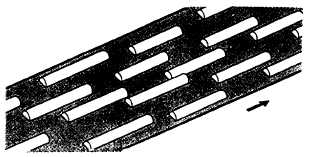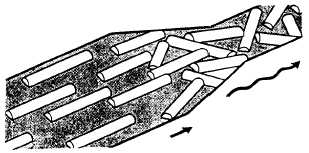velocity of flow at point A, v1, to the velocity of
flow at point B, v2.
Since Q1 = Q2, A1v1 = A2v2
From figure 2-13; A1 = 16sq. in., A2 = 4sq. in.
Substituting: 16v1 = 4V2 or v2 = 4vI
Therefore, the velocity of flow at point B is four
times the velocity of flow at point A.
VOLUME OF FLOW AND SPEED
If you consider the cylinder volume you must
fill and the distance the piston must travel, you
can relate the volume of flow to the speed of the
piston. The volume of the cylinder is found by
multiplying the piston area by the length the piston
must travel (stroke).
Suppose you have determined that two
cylinders have the same volume and that one
cylinder is twice as long as the other. In this case,
the cross-sectional area of the longer tube will be
half of the cross-sectional area of the other tube.
If fluid is pumped into each cylinder at the same
rate, both pistons will reach their full travel at the
same time. However, the piston in the smaller
cylinder must travel twice as fast because it has
twice as far to go.
There are two ways of controlling the speed
of the piston, (1) by varying the size of the cylinder
and (2) by varying the volume of flow (gpm) to
the cylinders. (Hydraulic cylinders are discussed
in detail in chapter 10. )
STREAMLINE AND
TURBULENT FLOW
At low velocities or in tubes of small diameter,
flow is streamlined. This means that a given
particle of fluid moves straight forward without
bumping into other particles and without crossing
their paths. Streamline flow is often referred to
as laminar flow, which is defined as a flow
situation in which fluid moves in parallel lamina
or layers. As an example of streamline flow,
consider figure 2-14, which illustrates an open
stream flowing at a slow, uniform rate with logs
floating on its surface. The logs represent particles
of fluid. As long as the stream flows at a slow,
uniform rate, each log floats downstream in its
Figure 2-14.—Streamline flow.
own path, without crossing or bumping into the
other.
If the stream narrows, however, and the
volume of flow remains the same, the velocity
of flow increases. If the velocity increases
sufficiently, the water becomes turbulent. (See
fig. 2-15.) Swirls, eddies, and cross-motions are
set up in the water. As this happens, the logs are
thrown against each other and against the banks
of the stream, and the paths followed by different
logs will cross and recross.
Particles of fluid flowing in pipes act in the
same manner. The flow is streamlined if the fluid
flows slowly enough, and remains streamlined at
greater velocities if the diameter of the pipe is
small. If the velocity of flow or size of pipe is
increased sufficiently, the flow becomes turbulent.
While a high velocity of flow will produce
turbulence in any pipe, other factors contribute
to turbulence. Among these are the roughness of
the inside of the pipe, obstructions, the degree of
curvature of bends, and the number of bends in
the pipe. In setting up or maintaining fluid power
systems, care should be taken to eliminate or
Figure 2-15.—Turbulent flow.
2-10




